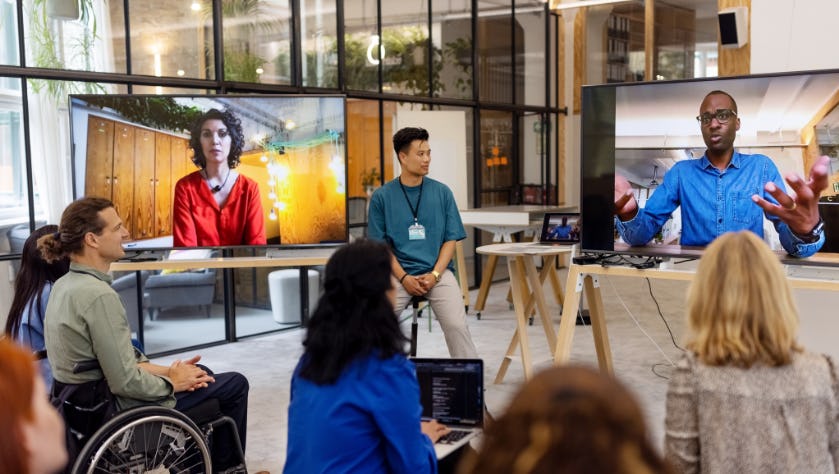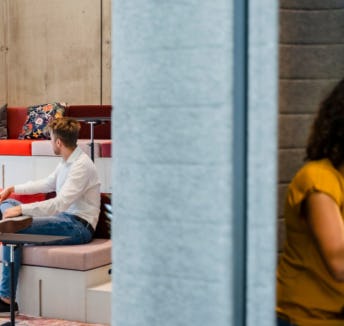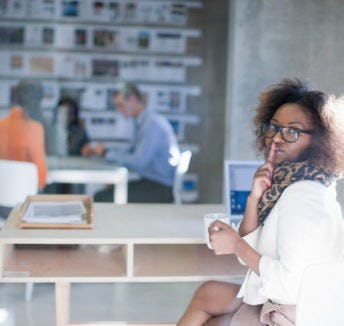
Meeting fatigue has set in, and people are looking for better ways to connect with each other. So does the answer lie in technology, finding the right space, or maybe a mix of everything? Read on for some game-changing tips.
We all remember a time when we could dip into a tray of sandwiches and enjoy a casual pre-meeting catch-up before getting the real work done. But with more meetings than ever moved online and those little joys less common, new stats from virtual conferencing company Redrex suggest we are in the midst of meeting fatigue. People are tired. Tired of staring at faces on screens, tired of waiting for everyone to turn up, and tired of the pointless chats where they’re just a spectator.
More and more people are viewing meetings as a time zap that stops them doing the actual work. According to the Redrex survey, 83 percent of employees spend up to a third of their working week in video meetings, and 71 per cent feel that they waste time. But as we get our heads around this new era of hybrid working, there are ways to make meetings productive and engaging again.
Sort the space
Hybrid working has naturally led to a slight lop-sidedness in terms of numbers of people in the office. There are some days, generally the mid-week ones, where desks are filled and there’s a buzz in the air. But come Monday and Friday turning up to work can feel a bit like you’ve gone to a party on the wrong day.
It can be tricky to find space for meetings on these surge days but by recognising the disparities, and working with them, employers can forward plan their meetings and cut down on the online catch-ups. Think of them as ‘deep work’ days (from home or a satellite office) and collaboration days (in office) where space is both booked in advance and set up in an agile way to enable impromptu meetings to happen.
Host it properly
The most effective meetings are well led. People know why they are there, what they are meant to be contributing, and it’s obvious who is leading it. New York Times writer Adam Bryant says that setting a clear agenda is rule number one. Summarising the points in the first few minutes acts as a steer, and equally, allowing a few moments at the end to sum up can help workers feel clarity. Annette Catino, chief executive of the QualCare Alliance Network, puts it succinctly: “Give me an agenda or else I’m not going to sit there, because if I don’t know why we’re in the meeting, and you don’t know why we’re there, then there’s no reason for a meeting.”
Over-emphasise those who are not in the room
It’s easy to hide or feel unheard when you’re not in the physical space, but there are various ways to help people feel included and relevant. A survey by Cisco suggests that 98 per cent of meetings will have at least one remote participant in the future, so ensuring you have the best tech is paramount. From the right audio to effective cameras, to large screens and live collaboration software like Google apps and Miro, it’s the tech that can make or break a hybrid meeting.
The Harvard Business Review suggests making remote participants life-sized by bringing in large monitors and positioning them around the table. Our Spaces meeting rooms come with big plug-and-go screens to create the same effect. “These large images help in-person attendees accept remote colleagues as full participants and provide a constant reminder to include them in the conversation,” they write.
Camera on
Of course, these life-sized screens require cameras on, and there’s not much that’s more divisive than cameras. A survey by the Harvard Business Review found that keeping the camera consistently on during meetings is at the heart of the fatigue problem, but then again, talking to a still image or even worse, someone’s initials, isn’t particularly inspiring either. The answer lies, like most things, in having variety. Specify some meetings where you need to see people. If staff still work from a bedroom or a kitchen table and they don’t want to feel like colleagues can see into their home, then the option of working from a flexspace or a satellite office can really help here. At other times, use the camera off walking meeting method. It’s good to mix things up.
Buddies
Another way to bridge any hybrid gaps is by having an in-person partner for every remote attendee. A buddy, if you like. This person can be the representative in the room, contacting their remote partner in real-time via instant messenger and ensuring their voice is heard.
And finally…
There is, of course, the metaverse. Where we’ll all feel like we are in the same place at the same time, perhaps beside a lake in digital land, where the sky is blue and the trees are square. So the head sets can be heavy, and the format takes some getting used to, but the metaverse is shaking things up and making meetings more fun. It’s also likely to play a large part in the future of work, so early adoption will absolutely make you a forward-thinking employer.
The trick to really nailing a meeting though, is to make them productive and cut out the unnecessary ones. Pick the right format for the subject and vary it – the era of hybrid work is about being agile and not sticking to the traditional formats out of habit.
Read more for advice and tips about hybrid-era working, and check out our app for easy meeting room bookings.
Share this article
 Read now Come on a journey: 2022’s biggest office trends
Read now Come on a journey: 2022’s biggest office trends
 Read now Quiet, please: Why employee preferences are still so important
Read now Quiet, please: Why employee preferences are still so important